Advance Financial Accounting: Impairment, Leases and ARB Corp.
VerifiedAdded on 2020/05/16
|10
|1624
|59
Report
AI Summary
This report provides a detailed analysis of advance financial accounting principles, focusing on the application of AASB standards. It examines the impairment of assets, including loans, receivables, goodwill, and property, plant, and equipment, in accordance with AASB 136. The report explores the subjectivity involved in impairment testing, particularly concerning goodwill, and discusses the challenges in determining impairment indications. Furthermore, it delves into lease accounting, comparing the former and new lease standards (IFRS 16), highlighting the impact of off-balance sheet operating leases and the lack of comparability under the old standards. The report also includes an analysis of ARB Corporation, a large distributor of 4x4 accessories, illustrating the practical application of these accounting principles and addressing the complexities of implementing new accounting standards within a company.
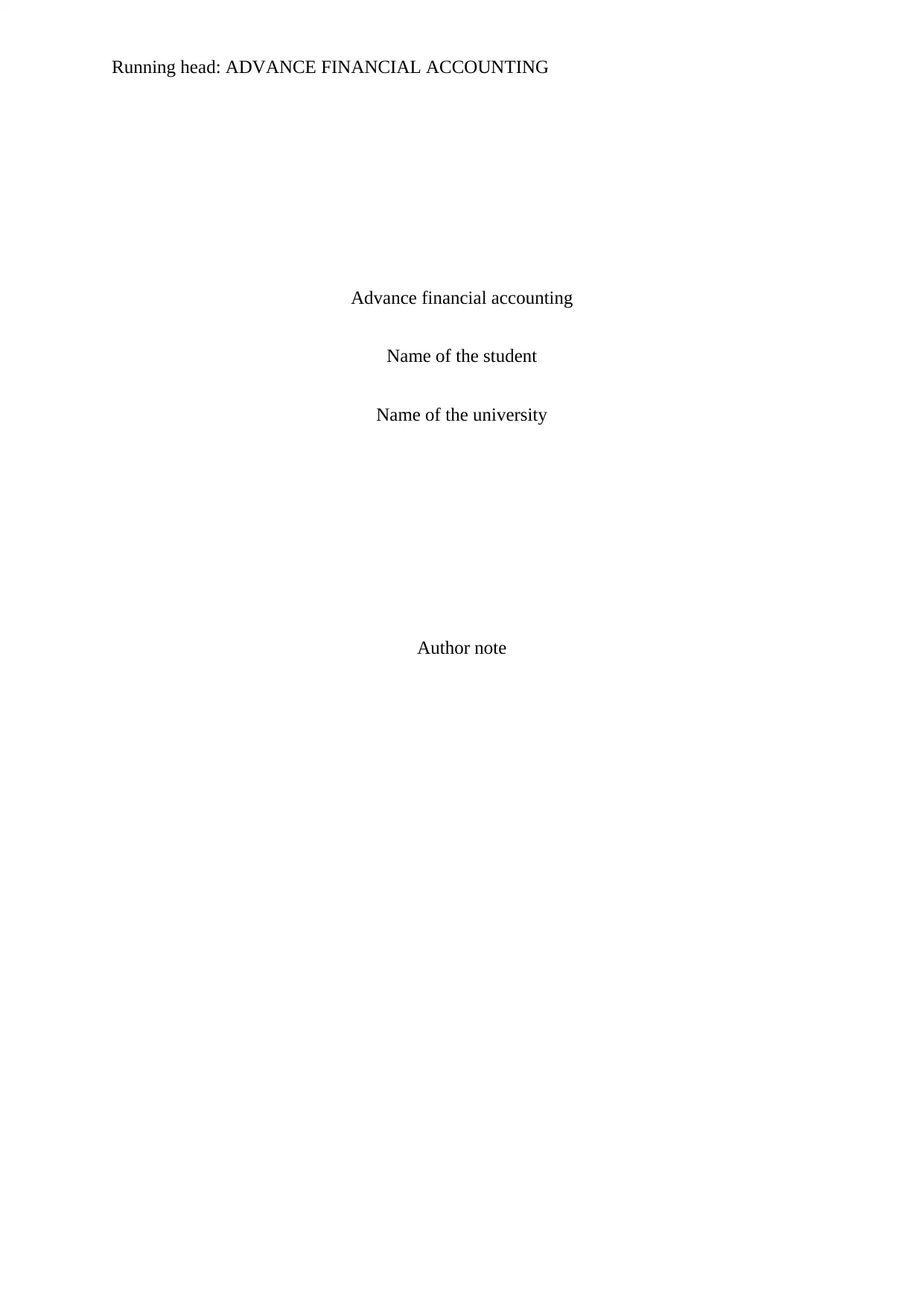
Running head: ADVANCE FINANCIAL ACCOUNTING
Advance financial accounting
Name of the student
Name of the university
Author note
Advance financial accounting
Name of the student
Name of the university
Author note
Paraphrase This Document
Need a fresh take? Get an instant paraphrase of this document with our AI Paraphraser
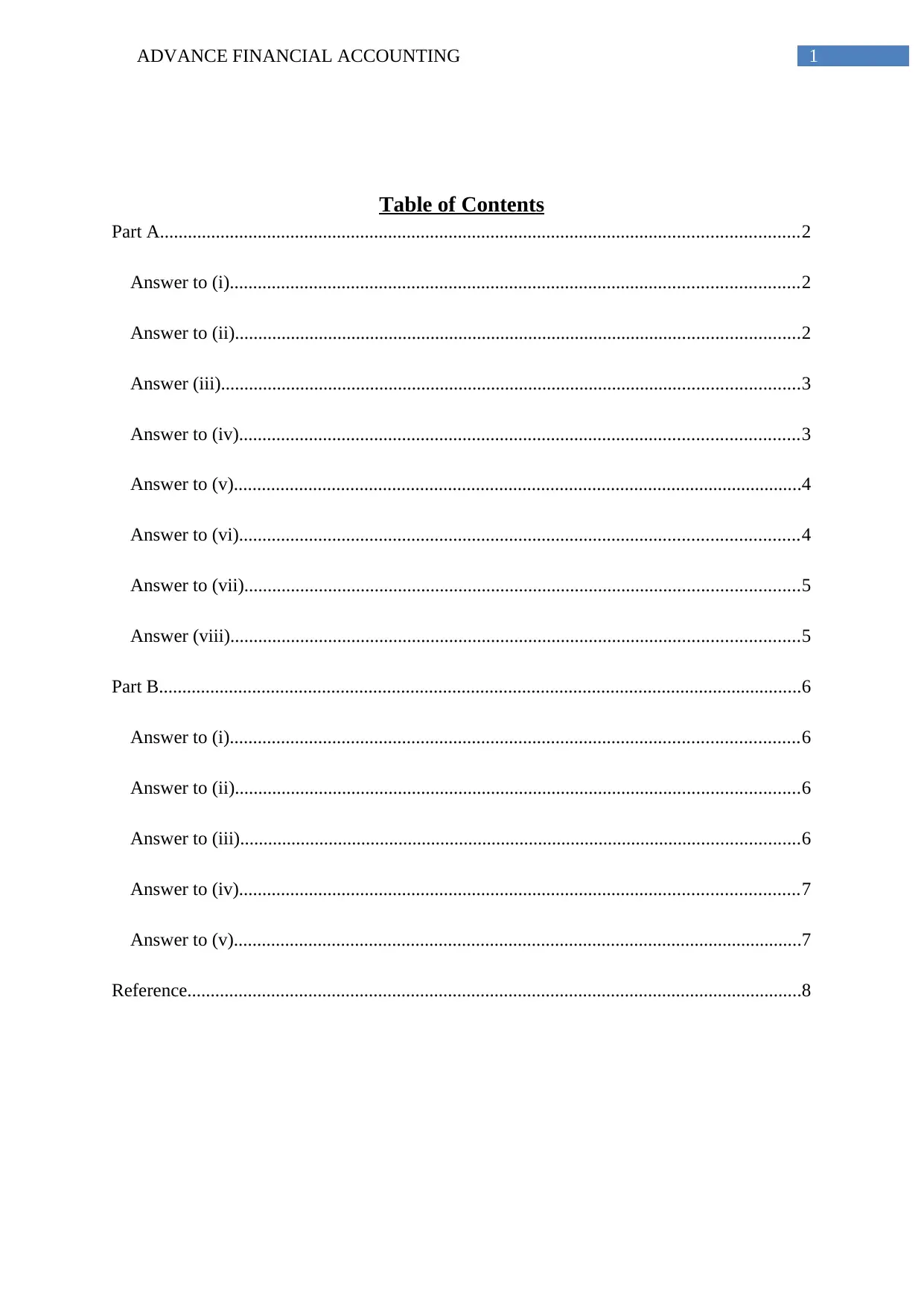
1ADVANCE FINANCIAL ACCOUNTING
Table of Contents
Part A.........................................................................................................................................2
Answer to (i)..........................................................................................................................2
Answer to (ii).........................................................................................................................2
Answer (iii)............................................................................................................................3
Answer to (iv)........................................................................................................................3
Answer to (v)..........................................................................................................................4
Answer to (vi)........................................................................................................................4
Answer to (vii).......................................................................................................................5
Answer (viii)..........................................................................................................................5
Part B..........................................................................................................................................6
Answer to (i)..........................................................................................................................6
Answer to (ii).........................................................................................................................6
Answer to (iii)........................................................................................................................6
Answer to (iv)........................................................................................................................7
Answer to (v)..........................................................................................................................7
Reference....................................................................................................................................8
Table of Contents
Part A.........................................................................................................................................2
Answer to (i)..........................................................................................................................2
Answer to (ii).........................................................................................................................2
Answer (iii)............................................................................................................................3
Answer to (iv)........................................................................................................................3
Answer to (v)..........................................................................................................................4
Answer to (vi)........................................................................................................................4
Answer to (vii).......................................................................................................................5
Answer (viii)..........................................................................................................................5
Part B..........................................................................................................................................6
Answer to (i)..........................................................................................................................6
Answer to (ii).........................................................................................................................6
Answer to (iii)........................................................................................................................6
Answer to (iv)........................................................................................................................7
Answer to (v)..........................................................................................................................7
Reference....................................................................................................................................8
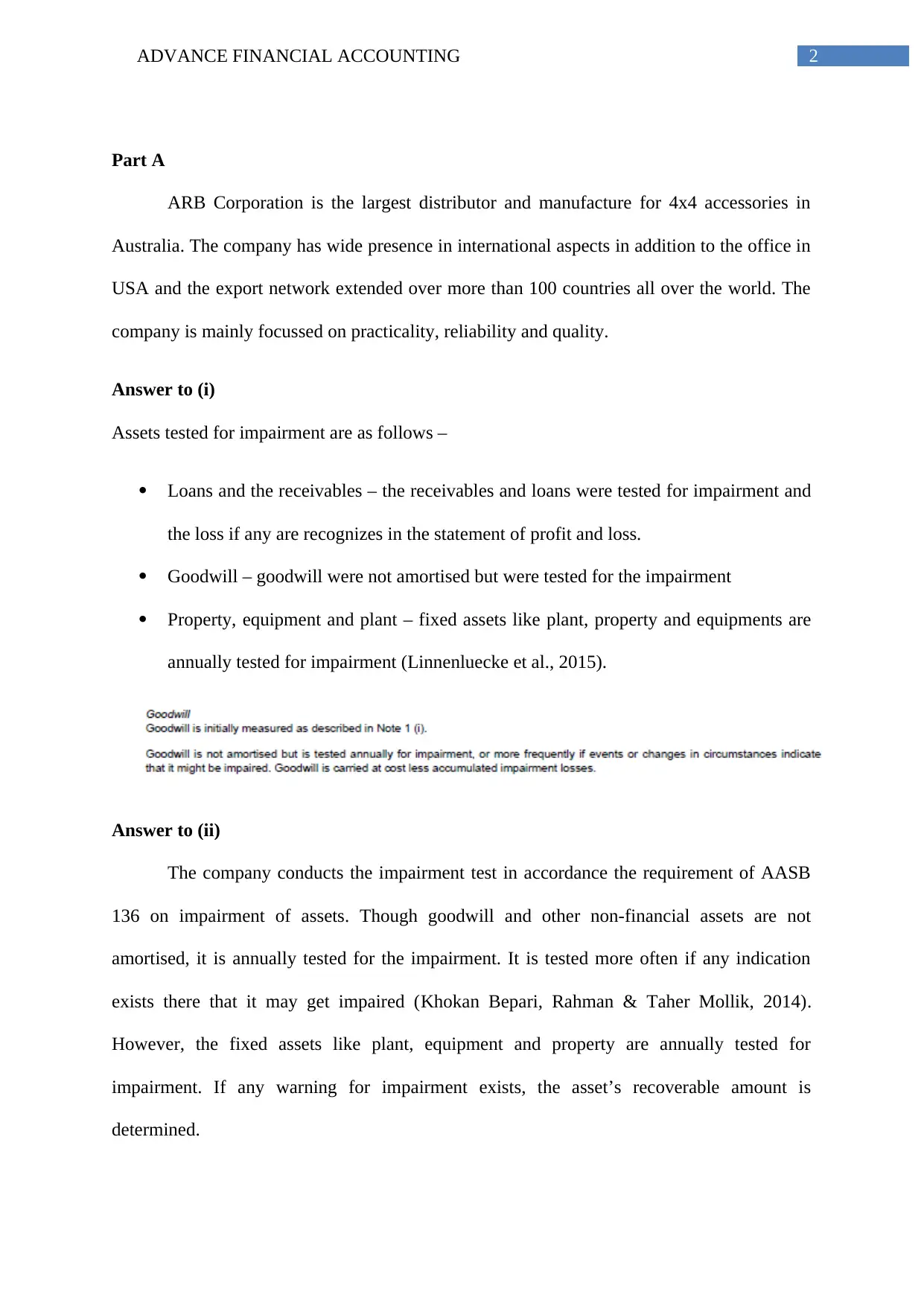
2ADVANCE FINANCIAL ACCOUNTING
Part A
ARB Corporation is the largest distributor and manufacture for 4x4 accessories in
Australia. The company has wide presence in international aspects in addition to the office in
USA and the export network extended over more than 100 countries all over the world. The
company is mainly focussed on practicality, reliability and quality.
Answer to (i)
Assets tested for impairment are as follows –
Loans and the receivables – the receivables and loans were tested for impairment and
the loss if any are recognizes in the statement of profit and loss.
Goodwill – goodwill were not amortised but were tested for the impairment
Property, equipment and plant – fixed assets like plant, property and equipments are
annually tested for impairment (Linnenluecke et al., 2015).
Answer to (ii)
The company conducts the impairment test in accordance the requirement of AASB
136 on impairment of assets. Though goodwill and other non-financial assets are not
amortised, it is annually tested for the impairment. It is tested more often if any indication
exists there that it may get impaired (Khokan Bepari, Rahman & Taher Mollik, 2014).
However, the fixed assets like plant, equipment and property are annually tested for
impairment. If any warning for impairment exists, the asset’s recoverable amount is
determined.
Part A
ARB Corporation is the largest distributor and manufacture for 4x4 accessories in
Australia. The company has wide presence in international aspects in addition to the office in
USA and the export network extended over more than 100 countries all over the world. The
company is mainly focussed on practicality, reliability and quality.
Answer to (i)
Assets tested for impairment are as follows –
Loans and the receivables – the receivables and loans were tested for impairment and
the loss if any are recognizes in the statement of profit and loss.
Goodwill – goodwill were not amortised but were tested for the impairment
Property, equipment and plant – fixed assets like plant, property and equipments are
annually tested for impairment (Linnenluecke et al., 2015).
Answer to (ii)
The company conducts the impairment test in accordance the requirement of AASB
136 on impairment of assets. Though goodwill and other non-financial assets are not
amortised, it is annually tested for the impairment. It is tested more often if any indication
exists there that it may get impaired (Khokan Bepari, Rahman & Taher Mollik, 2014).
However, the fixed assets like plant, equipment and property are annually tested for
impairment. If any warning for impairment exists, the asset’s recoverable amount is
determined.
⊘ This is a preview!⊘
Do you want full access?
Subscribe today to unlock all pages.

Trusted by 1+ million students worldwide
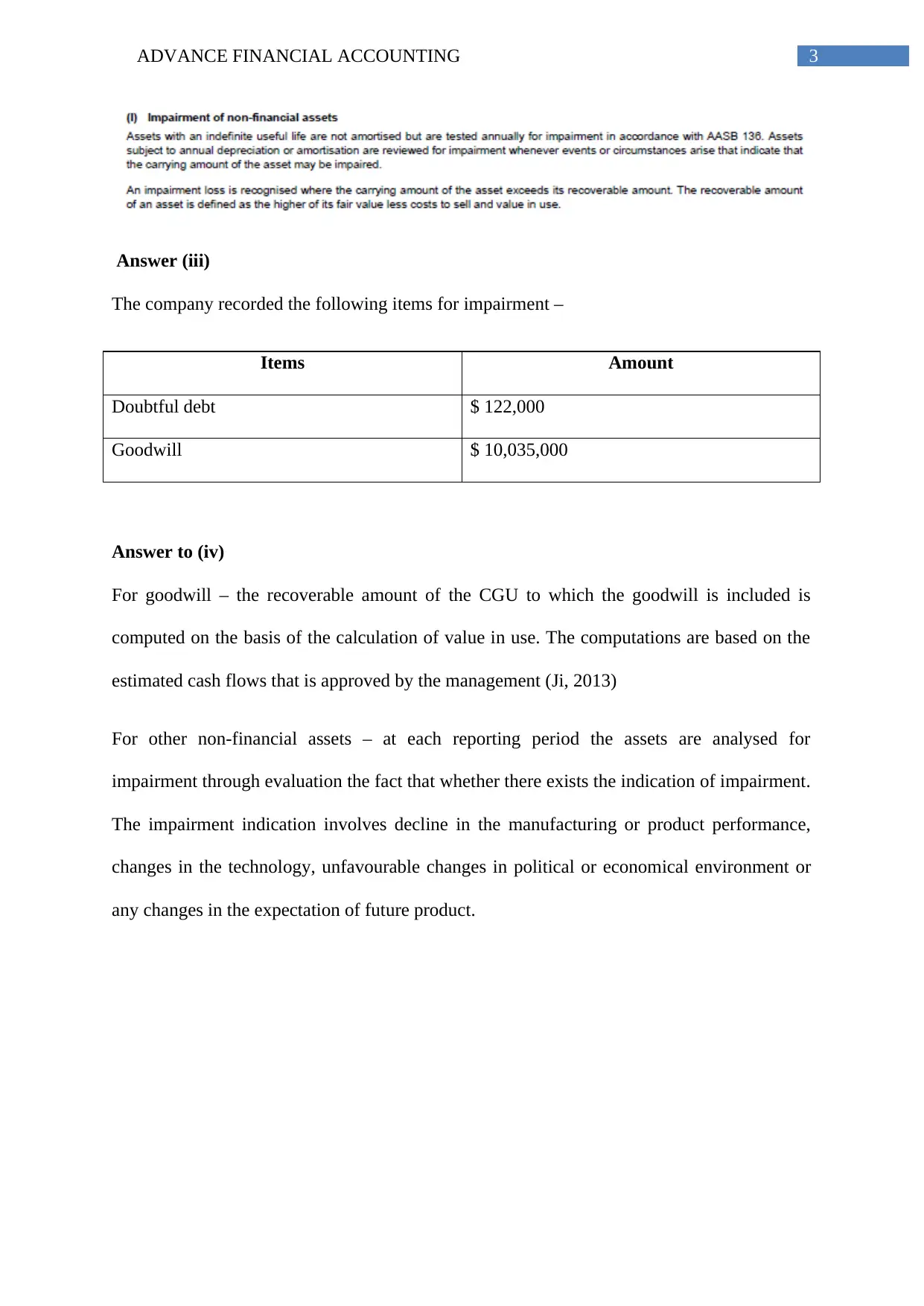
3ADVANCE FINANCIAL ACCOUNTING
Answer (iii)
The company recorded the following items for impairment –
Items Amount
Doubtful debt $ 122,000
Goodwill $ 10,035,000
Answer to (iv)
For goodwill – the recoverable amount of the CGU to which the goodwill is included is
computed on the basis of the calculation of value in use. The computations are based on the
estimated cash flows that is approved by the management (Ji, 2013)
For other non-financial assets – at each reporting period the assets are analysed for
impairment through evaluation the fact that whether there exists the indication of impairment.
The impairment indication involves decline in the manufacturing or product performance,
changes in the technology, unfavourable changes in political or economical environment or
any changes in the expectation of future product.
Answer (iii)
The company recorded the following items for impairment –
Items Amount
Doubtful debt $ 122,000
Goodwill $ 10,035,000
Answer to (iv)
For goodwill – the recoverable amount of the CGU to which the goodwill is included is
computed on the basis of the calculation of value in use. The computations are based on the
estimated cash flows that is approved by the management (Ji, 2013)
For other non-financial assets – at each reporting period the assets are analysed for
impairment through evaluation the fact that whether there exists the indication of impairment.
The impairment indication involves decline in the manufacturing or product performance,
changes in the technology, unfavourable changes in political or economical environment or
any changes in the expectation of future product.
Paraphrase This Document
Need a fresh take? Get an instant paraphrase of this document with our AI Paraphraser
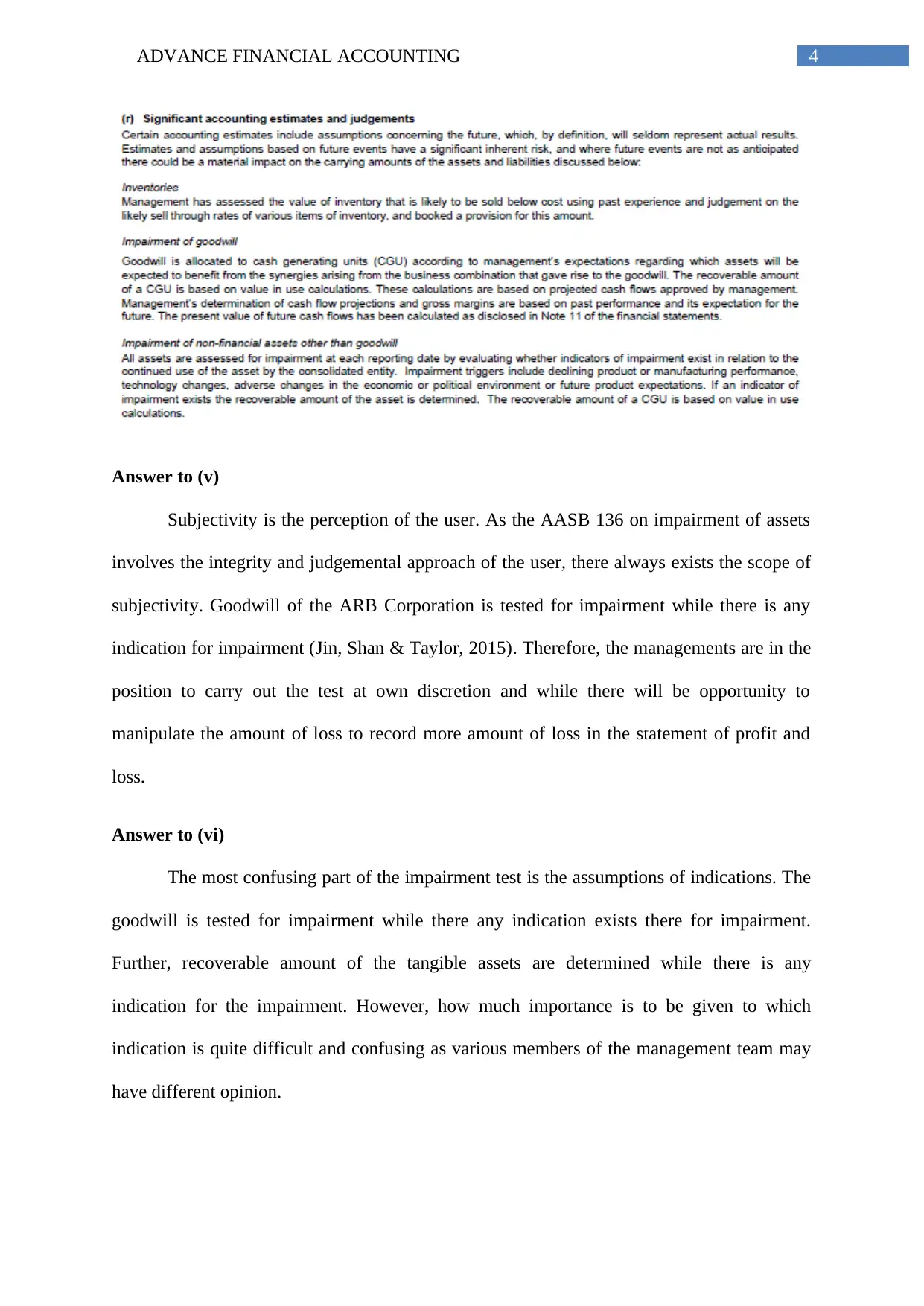
4ADVANCE FINANCIAL ACCOUNTING
Answer to (v)
Subjectivity is the perception of the user. As the AASB 136 on impairment of assets
involves the integrity and judgemental approach of the user, there always exists the scope of
subjectivity. Goodwill of the ARB Corporation is tested for impairment while there is any
indication for impairment (Jin, Shan & Taylor, 2015). Therefore, the managements are in the
position to carry out the test at own discretion and while there will be opportunity to
manipulate the amount of loss to record more amount of loss in the statement of profit and
loss.
Answer to (vi)
The most confusing part of the impairment test is the assumptions of indications. The
goodwill is tested for impairment while there any indication exists there for impairment.
Further, recoverable amount of the tangible assets are determined while there is any
indication for the impairment. However, how much importance is to be given to which
indication is quite difficult and confusing as various members of the management team may
have different opinion.
Answer to (v)
Subjectivity is the perception of the user. As the AASB 136 on impairment of assets
involves the integrity and judgemental approach of the user, there always exists the scope of
subjectivity. Goodwill of the ARB Corporation is tested for impairment while there is any
indication for impairment (Jin, Shan & Taylor, 2015). Therefore, the managements are in the
position to carry out the test at own discretion and while there will be opportunity to
manipulate the amount of loss to record more amount of loss in the statement of profit and
loss.
Answer to (vi)
The most confusing part of the impairment test is the assumptions of indications. The
goodwill is tested for impairment while there any indication exists there for impairment.
Further, recoverable amount of the tangible assets are determined while there is any
indication for the impairment. However, how much importance is to be given to which
indication is quite difficult and confusing as various members of the management team may
have different opinion.
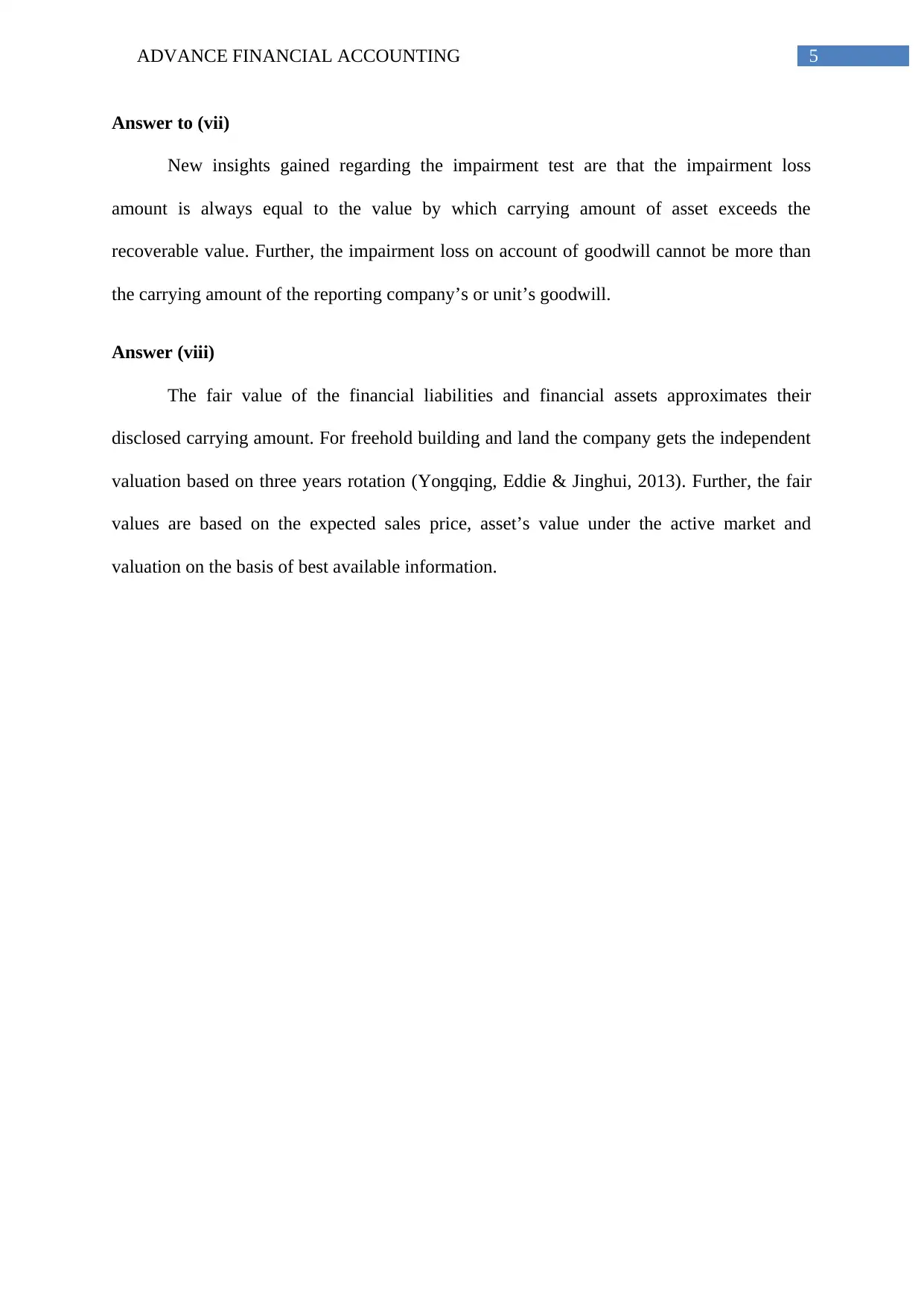
5ADVANCE FINANCIAL ACCOUNTING
Answer to (vii)
New insights gained regarding the impairment test are that the impairment loss
amount is always equal to the value by which carrying amount of asset exceeds the
recoverable value. Further, the impairment loss on account of goodwill cannot be more than
the carrying amount of the reporting company’s or unit’s goodwill.
Answer (viii)
The fair value of the financial liabilities and financial assets approximates their
disclosed carrying amount. For freehold building and land the company gets the independent
valuation based on three years rotation (Yongqing, Eddie & Jinghui, 2013). Further, the fair
values are based on the expected sales price, asset’s value under the active market and
valuation on the basis of best available information.
Answer to (vii)
New insights gained regarding the impairment test are that the impairment loss
amount is always equal to the value by which carrying amount of asset exceeds the
recoverable value. Further, the impairment loss on account of goodwill cannot be more than
the carrying amount of the reporting company’s or unit’s goodwill.
Answer (viii)
The fair value of the financial liabilities and financial assets approximates their
disclosed carrying amount. For freehold building and land the company gets the independent
valuation based on three years rotation (Yongqing, Eddie & Jinghui, 2013). Further, the fair
values are based on the expected sales price, asset’s value under the active market and
valuation on the basis of best available information.
⊘ This is a preview!⊘
Do you want full access?
Subscribe today to unlock all pages.

Trusted by 1+ million students worldwide
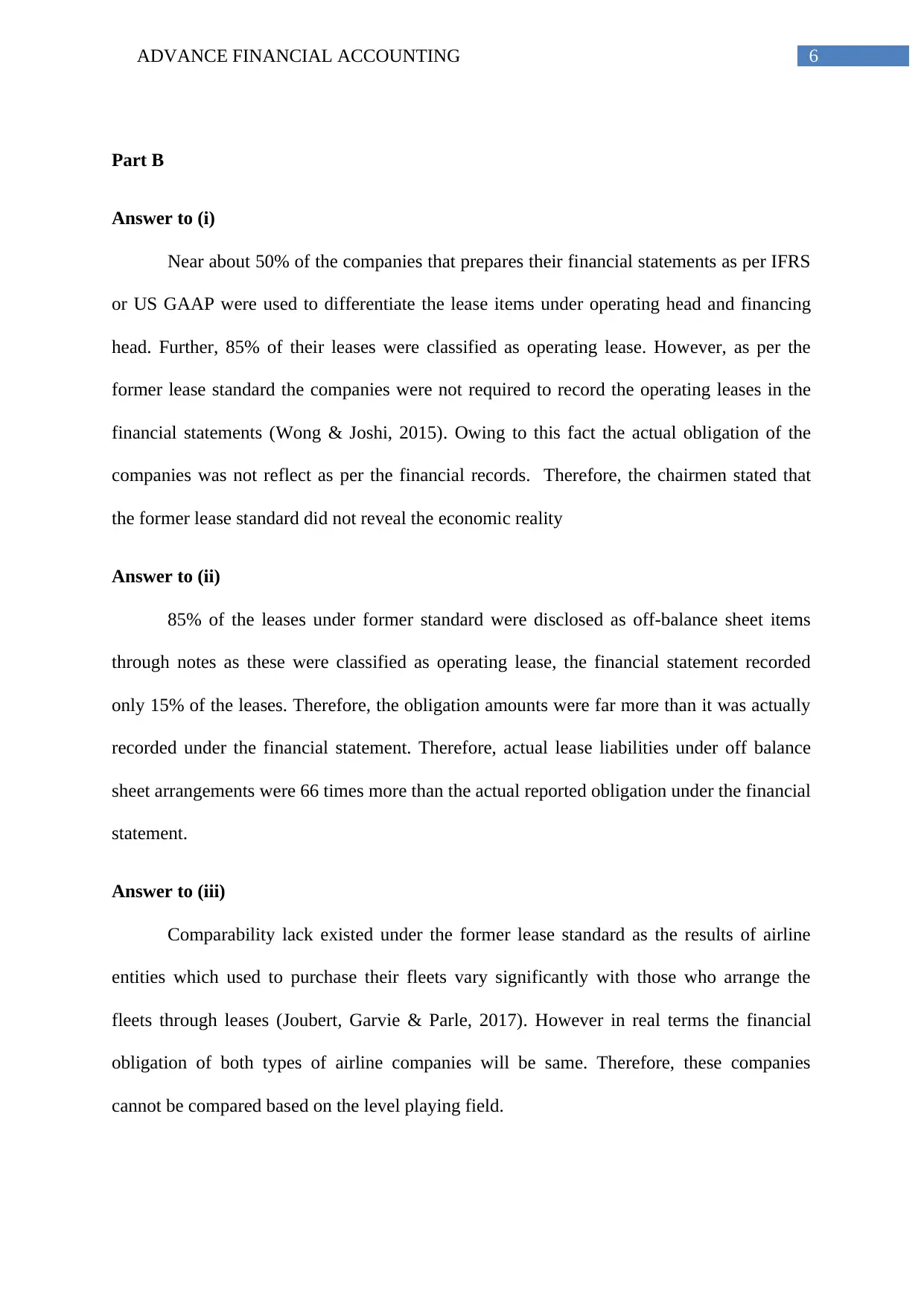
6ADVANCE FINANCIAL ACCOUNTING
Part B
Answer to (i)
Near about 50% of the companies that prepares their financial statements as per IFRS
or US GAAP were used to differentiate the lease items under operating head and financing
head. Further, 85% of their leases were classified as operating lease. However, as per the
former lease standard the companies were not required to record the operating leases in the
financial statements (Wong & Joshi, 2015). Owing to this fact the actual obligation of the
companies was not reflect as per the financial records. Therefore, the chairmen stated that
the former lease standard did not reveal the economic reality
Answer to (ii)
85% of the leases under former standard were disclosed as off-balance sheet items
through notes as these were classified as operating lease, the financial statement recorded
only 15% of the leases. Therefore, the obligation amounts were far more than it was actually
recorded under the financial statement. Therefore, actual lease liabilities under off balance
sheet arrangements were 66 times more than the actual reported obligation under the financial
statement.
Answer to (iii)
Comparability lack existed under the former lease standard as the results of airline
entities which used to purchase their fleets vary significantly with those who arrange the
fleets through leases (Joubert, Garvie & Parle, 2017). However in real terms the financial
obligation of both types of airline companies will be same. Therefore, these companies
cannot be compared based on the level playing field.
Part B
Answer to (i)
Near about 50% of the companies that prepares their financial statements as per IFRS
or US GAAP were used to differentiate the lease items under operating head and financing
head. Further, 85% of their leases were classified as operating lease. However, as per the
former lease standard the companies were not required to record the operating leases in the
financial statements (Wong & Joshi, 2015). Owing to this fact the actual obligation of the
companies was not reflect as per the financial records. Therefore, the chairmen stated that
the former lease standard did not reveal the economic reality
Answer to (ii)
85% of the leases under former standard were disclosed as off-balance sheet items
through notes as these were classified as operating lease, the financial statement recorded
only 15% of the leases. Therefore, the obligation amounts were far more than it was actually
recorded under the financial statement. Therefore, actual lease liabilities under off balance
sheet arrangements were 66 times more than the actual reported obligation under the financial
statement.
Answer to (iii)
Comparability lack existed under the former lease standard as the results of airline
entities which used to purchase their fleets vary significantly with those who arrange the
fleets through leases (Joubert, Garvie & Parle, 2017). However in real terms the financial
obligation of both types of airline companies will be same. Therefore, these companies
cannot be compared based on the level playing field.
Paraphrase This Document
Need a fresh take? Get an instant paraphrase of this document with our AI Paraphraser
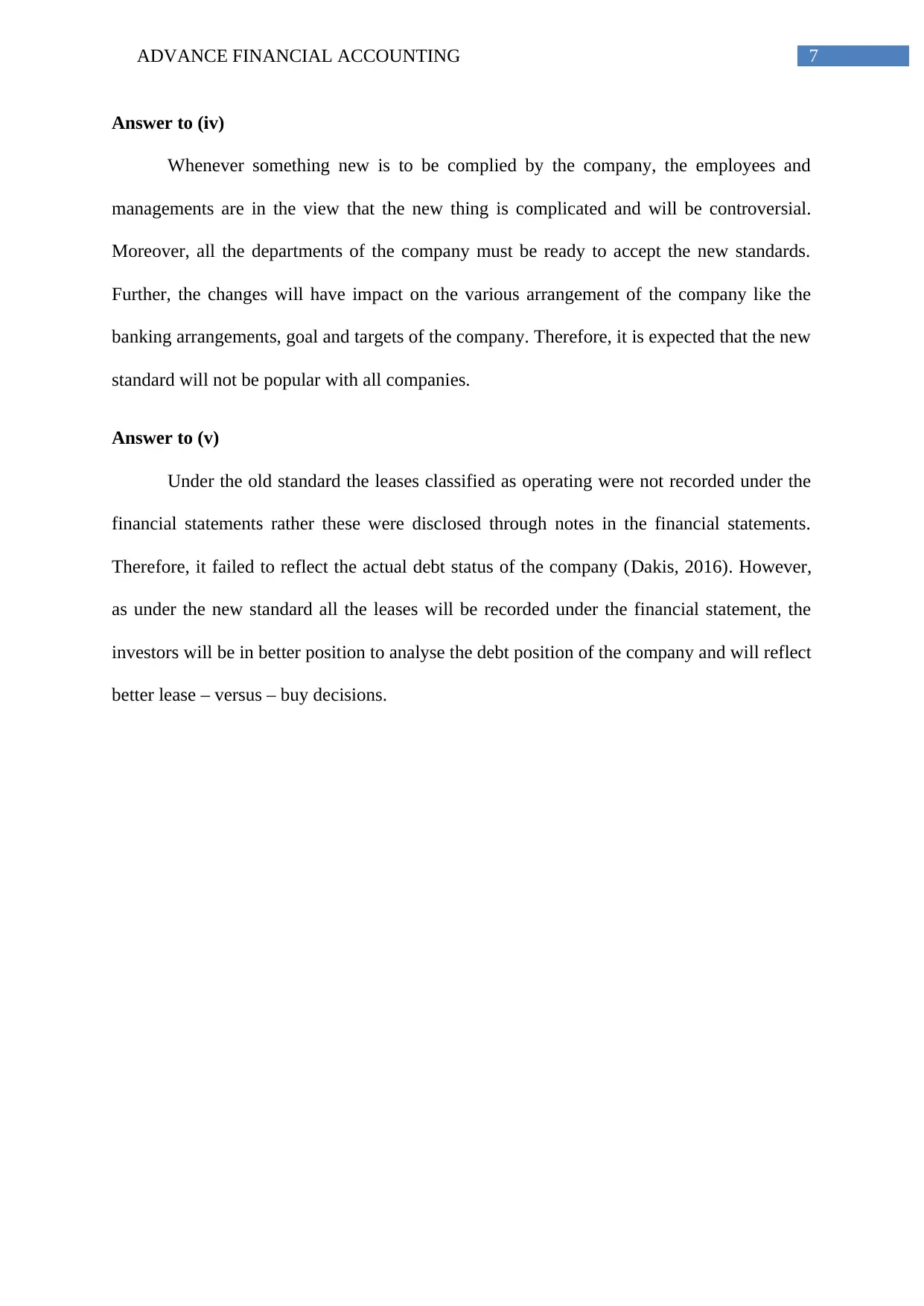
7ADVANCE FINANCIAL ACCOUNTING
Answer to (iv)
Whenever something new is to be complied by the company, the employees and
managements are in the view that the new thing is complicated and will be controversial.
Moreover, all the departments of the company must be ready to accept the new standards.
Further, the changes will have impact on the various arrangement of the company like the
banking arrangements, goal and targets of the company. Therefore, it is expected that the new
standard will not be popular with all companies.
Answer to (v)
Under the old standard the leases classified as operating were not recorded under the
financial statements rather these were disclosed through notes in the financial statements.
Therefore, it failed to reflect the actual debt status of the company (Dakis, 2016). However,
as under the new standard all the leases will be recorded under the financial statement, the
investors will be in better position to analyse the debt position of the company and will reflect
better lease – versus – buy decisions.
Answer to (iv)
Whenever something new is to be complied by the company, the employees and
managements are in the view that the new thing is complicated and will be controversial.
Moreover, all the departments of the company must be ready to accept the new standards.
Further, the changes will have impact on the various arrangement of the company like the
banking arrangements, goal and targets of the company. Therefore, it is expected that the new
standard will not be popular with all companies.
Answer to (v)
Under the old standard the leases classified as operating were not recorded under the
financial statements rather these were disclosed through notes in the financial statements.
Therefore, it failed to reflect the actual debt status of the company (Dakis, 2016). However,
as under the new standard all the leases will be recorded under the financial statement, the
investors will be in better position to analyse the debt position of the company and will reflect
better lease – versus – buy decisions.
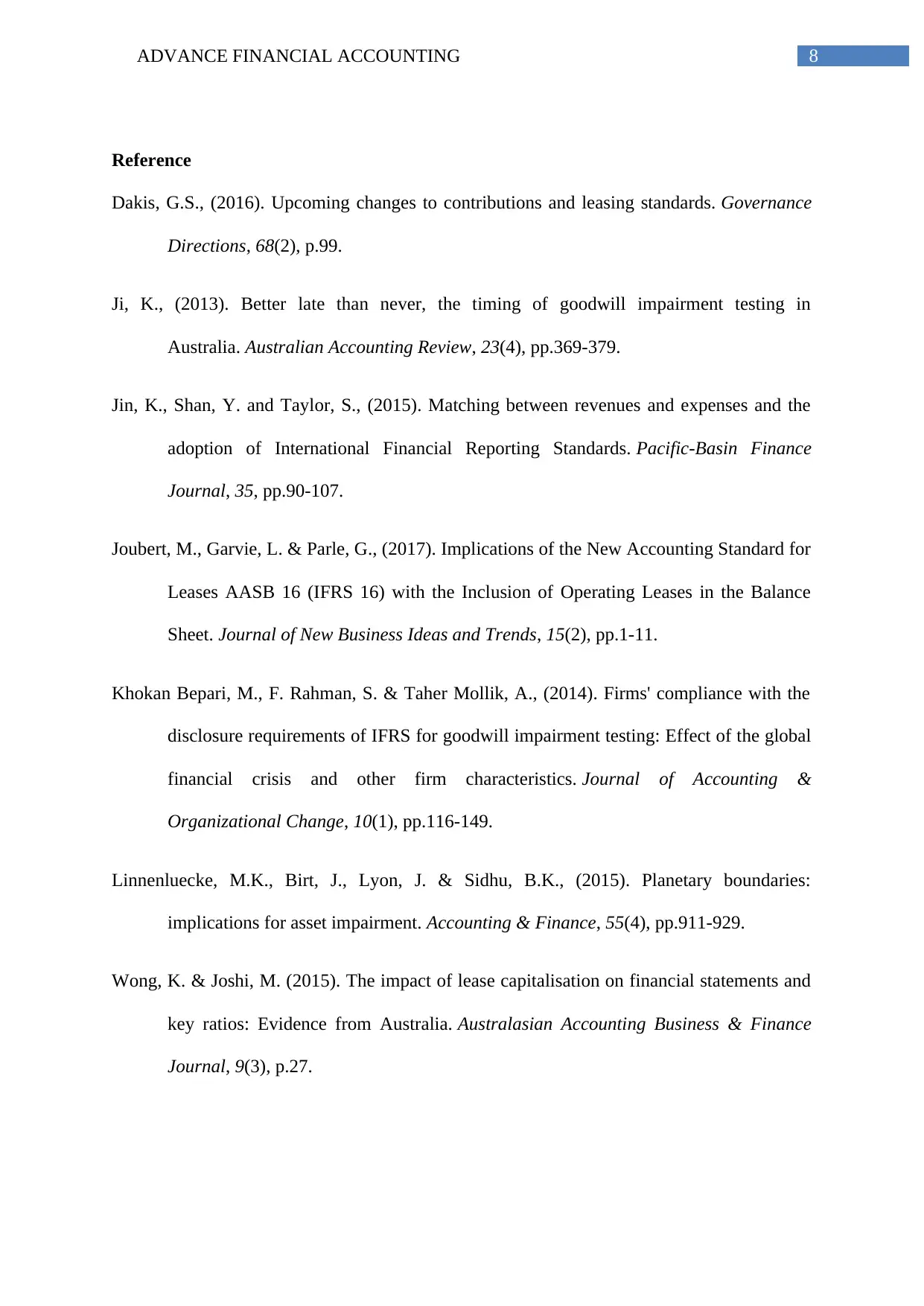
8ADVANCE FINANCIAL ACCOUNTING
Reference
Dakis, G.S., (2016). Upcoming changes to contributions and leasing standards. Governance
Directions, 68(2), p.99.
Ji, K., (2013). Better late than never, the timing of goodwill impairment testing in
Australia. Australian Accounting Review, 23(4), pp.369-379.
Jin, K., Shan, Y. and Taylor, S., (2015). Matching between revenues and expenses and the
adoption of International Financial Reporting Standards. Pacific-Basin Finance
Journal, 35, pp.90-107.
Joubert, M., Garvie, L. & Parle, G., (2017). Implications of the New Accounting Standard for
Leases AASB 16 (IFRS 16) with the Inclusion of Operating Leases in the Balance
Sheet. Journal of New Business Ideas and Trends, 15(2), pp.1-11.
Khokan Bepari, M., F. Rahman, S. & Taher Mollik, A., (2014). Firms' compliance with the
disclosure requirements of IFRS for goodwill impairment testing: Effect of the global
financial crisis and other firm characteristics. Journal of Accounting &
Organizational Change, 10(1), pp.116-149.
Linnenluecke, M.K., Birt, J., Lyon, J. & Sidhu, B.K., (2015). Planetary boundaries:
implications for asset impairment. Accounting & Finance, 55(4), pp.911-929.
Wong, K. & Joshi, M. (2015). The impact of lease capitalisation on financial statements and
key ratios: Evidence from Australia. Australasian Accounting Business & Finance
Journal, 9(3), p.27.
Reference
Dakis, G.S., (2016). Upcoming changes to contributions and leasing standards. Governance
Directions, 68(2), p.99.
Ji, K., (2013). Better late than never, the timing of goodwill impairment testing in
Australia. Australian Accounting Review, 23(4), pp.369-379.
Jin, K., Shan, Y. and Taylor, S., (2015). Matching between revenues and expenses and the
adoption of International Financial Reporting Standards. Pacific-Basin Finance
Journal, 35, pp.90-107.
Joubert, M., Garvie, L. & Parle, G., (2017). Implications of the New Accounting Standard for
Leases AASB 16 (IFRS 16) with the Inclusion of Operating Leases in the Balance
Sheet. Journal of New Business Ideas and Trends, 15(2), pp.1-11.
Khokan Bepari, M., F. Rahman, S. & Taher Mollik, A., (2014). Firms' compliance with the
disclosure requirements of IFRS for goodwill impairment testing: Effect of the global
financial crisis and other firm characteristics. Journal of Accounting &
Organizational Change, 10(1), pp.116-149.
Linnenluecke, M.K., Birt, J., Lyon, J. & Sidhu, B.K., (2015). Planetary boundaries:
implications for asset impairment. Accounting & Finance, 55(4), pp.911-929.
Wong, K. & Joshi, M. (2015). The impact of lease capitalisation on financial statements and
key ratios: Evidence from Australia. Australasian Accounting Business & Finance
Journal, 9(3), p.27.
⊘ This is a preview!⊘
Do you want full access?
Subscribe today to unlock all pages.

Trusted by 1+ million students worldwide
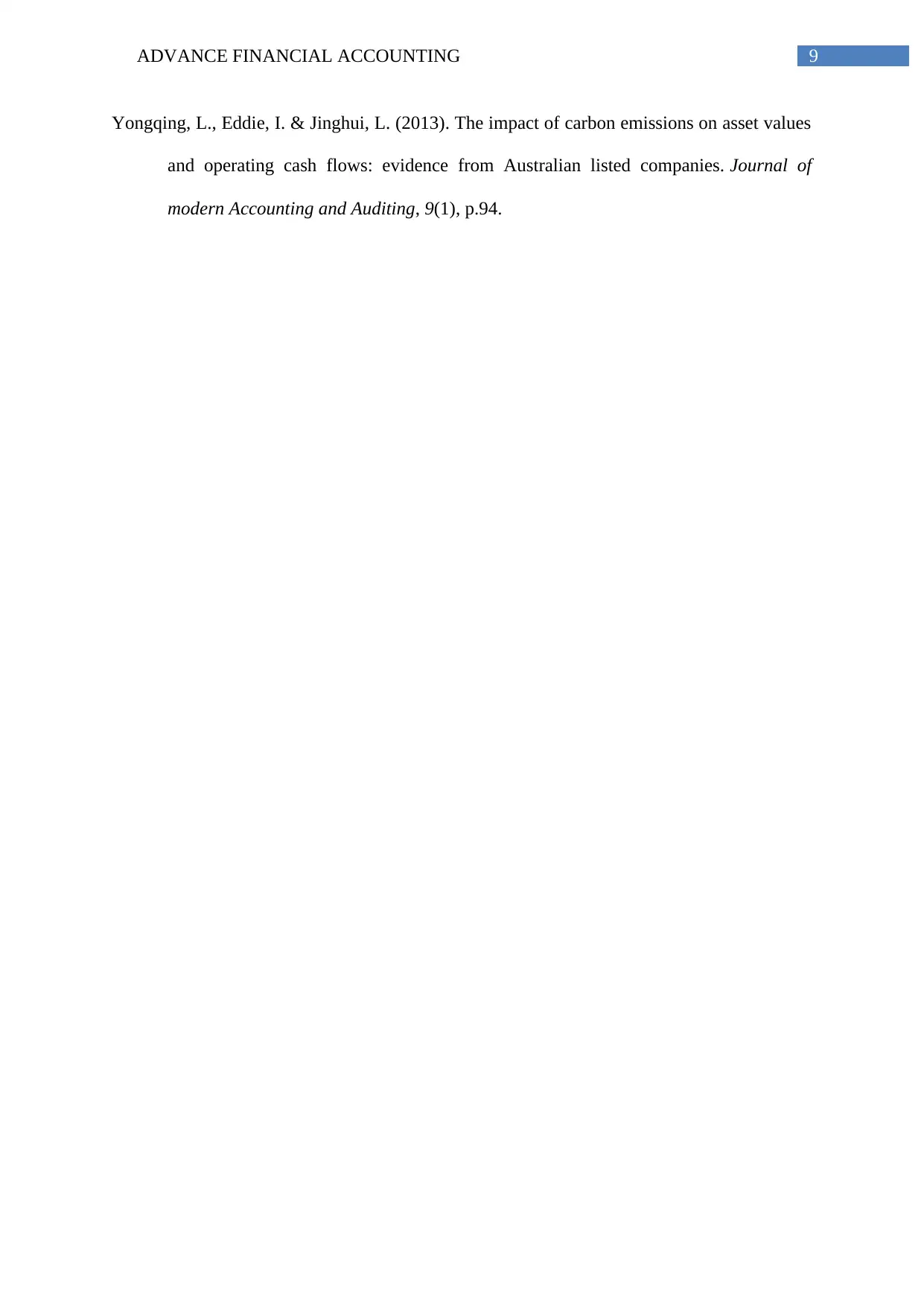
9ADVANCE FINANCIAL ACCOUNTING
Yongqing, L., Eddie, I. & Jinghui, L. (2013). The impact of carbon emissions on asset values
and operating cash flows: evidence from Australian listed companies. Journal of
modern Accounting and Auditing, 9(1), p.94.
Yongqing, L., Eddie, I. & Jinghui, L. (2013). The impact of carbon emissions on asset values
and operating cash flows: evidence from Australian listed companies. Journal of
modern Accounting and Auditing, 9(1), p.94.
1 out of 10
Related Documents
Your All-in-One AI-Powered Toolkit for Academic Success.
+13062052269
info@desklib.com
Available 24*7 on WhatsApp / Email
![[object Object]](/_next/static/media/star-bottom.7253800d.svg)
Unlock your academic potential
Copyright © 2020–2025 A2Z Services. All Rights Reserved. Developed and managed by ZUCOL.





